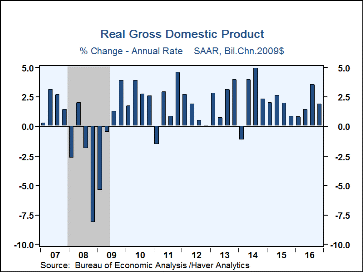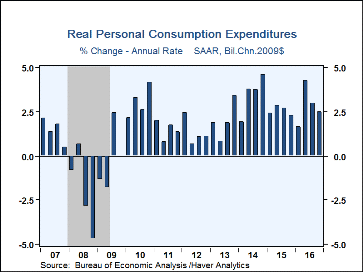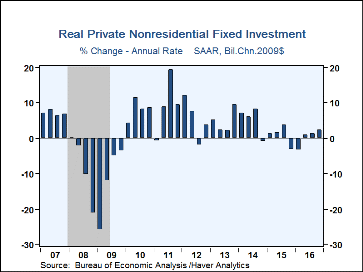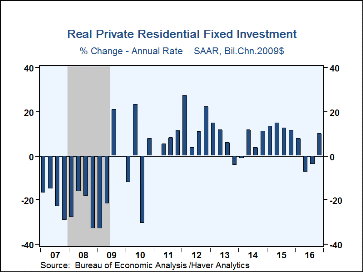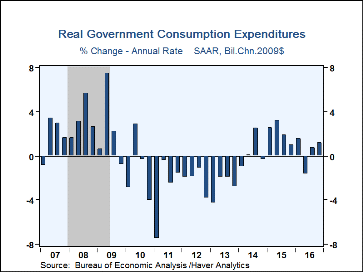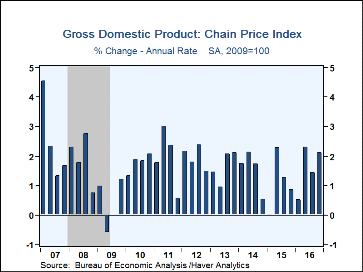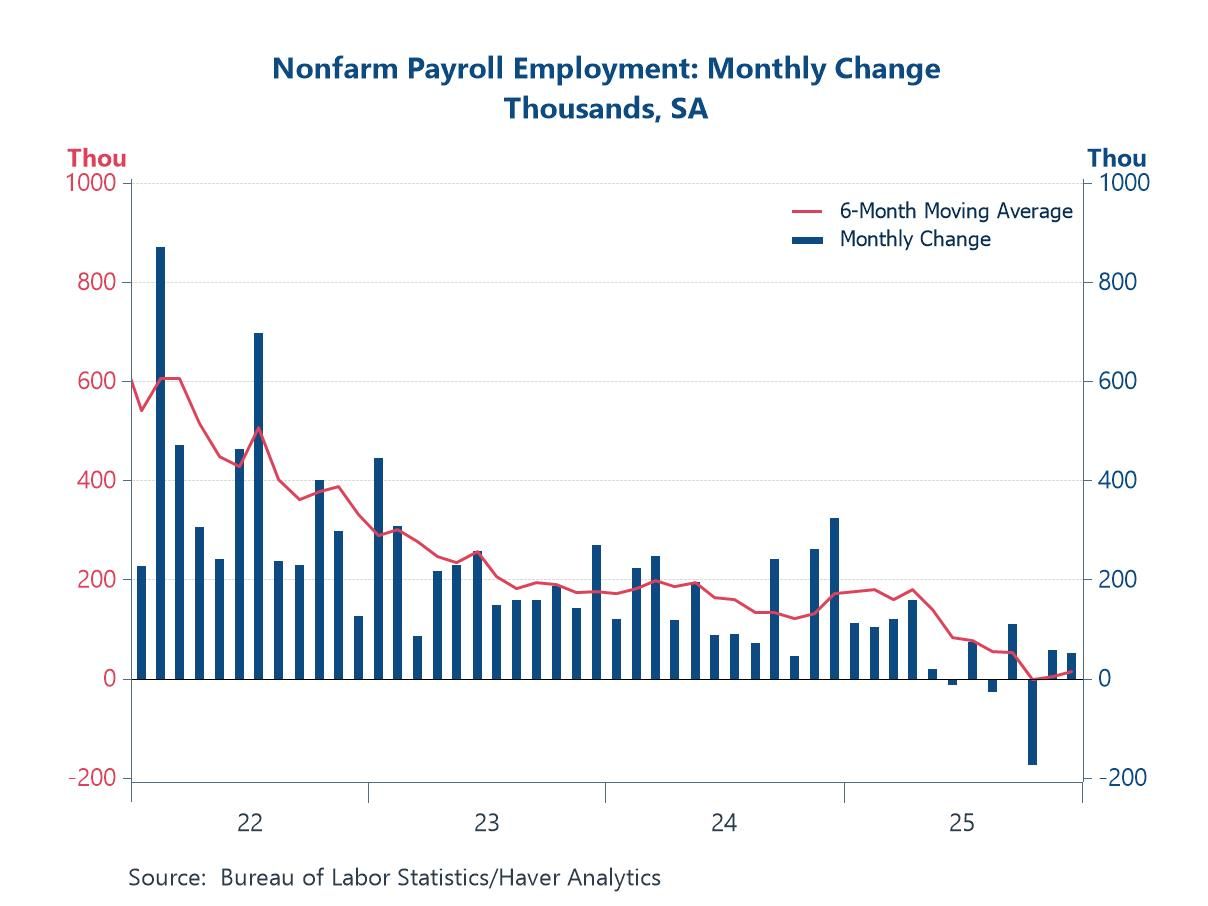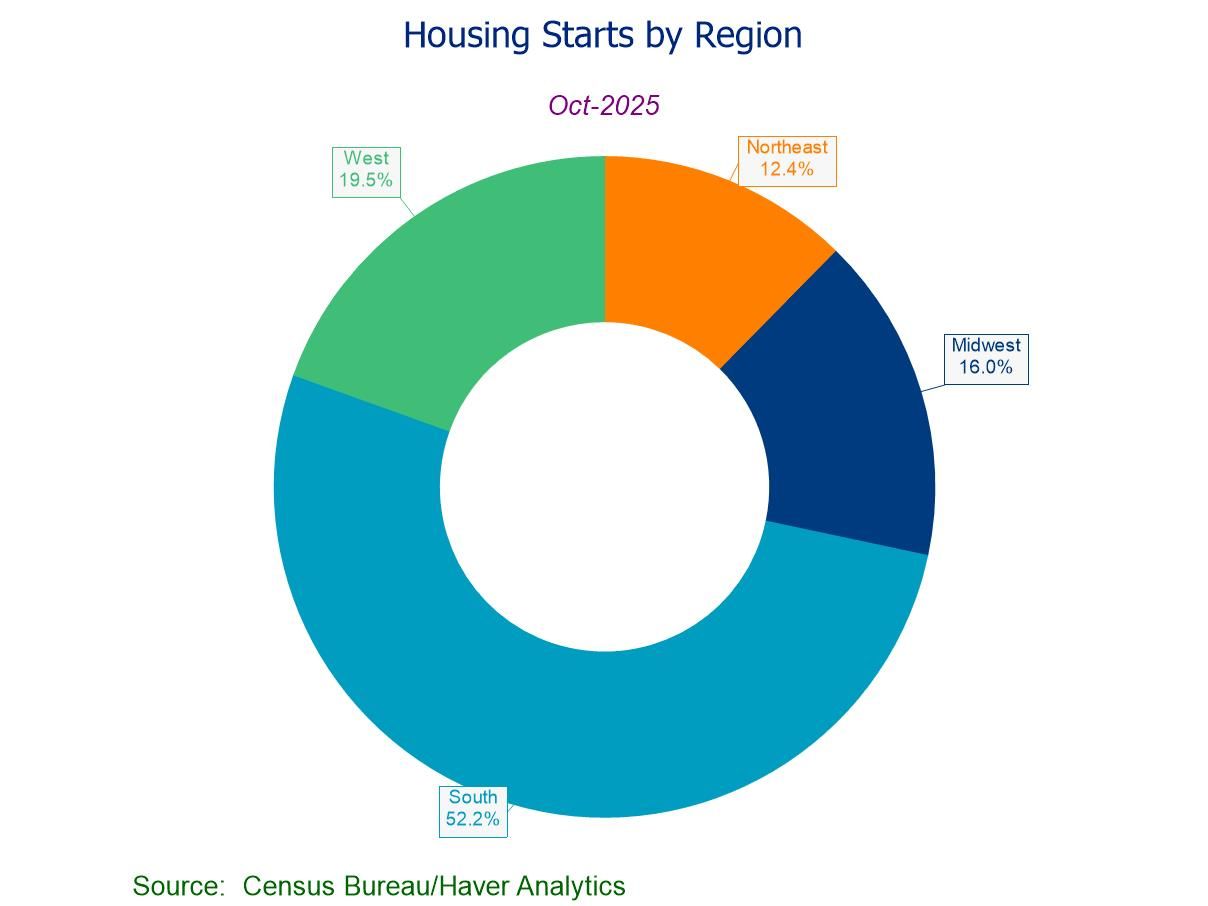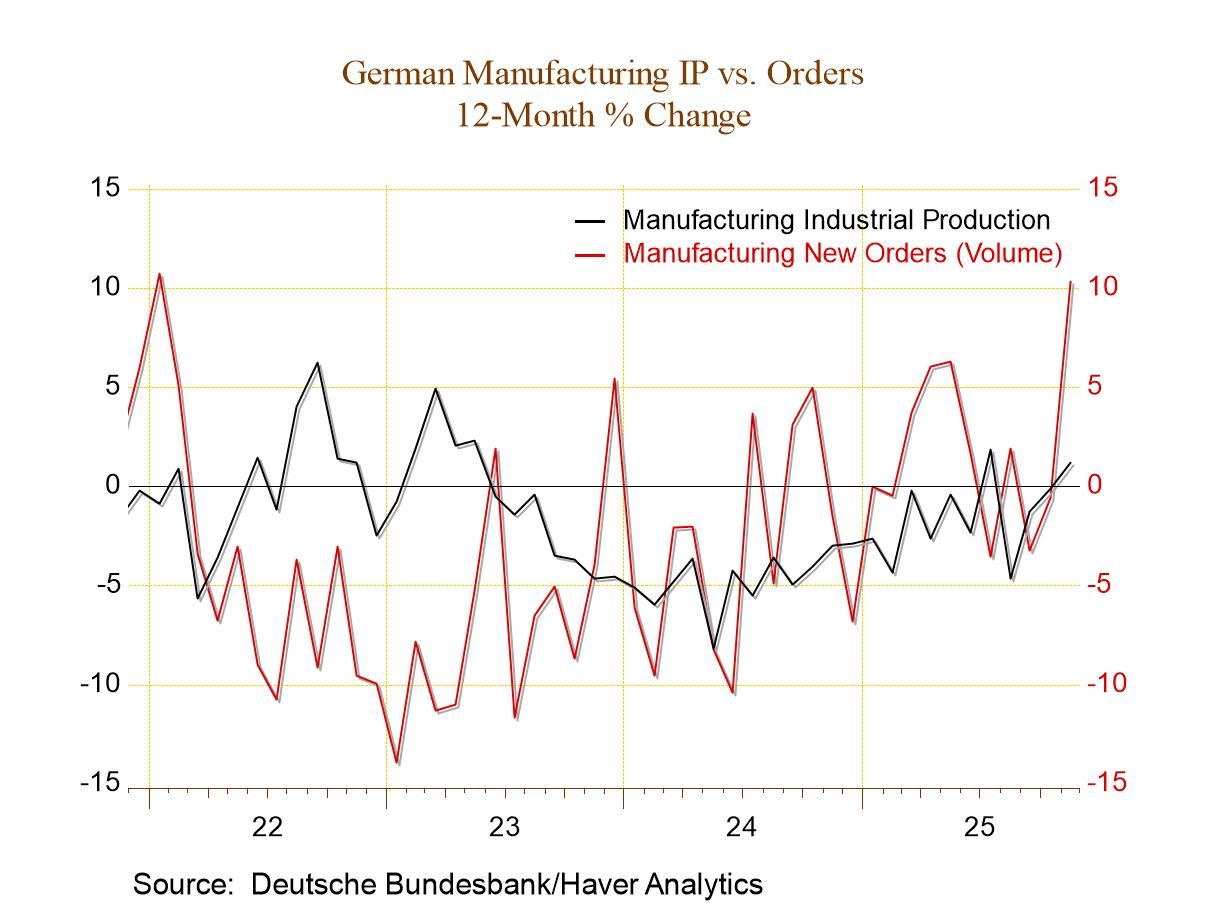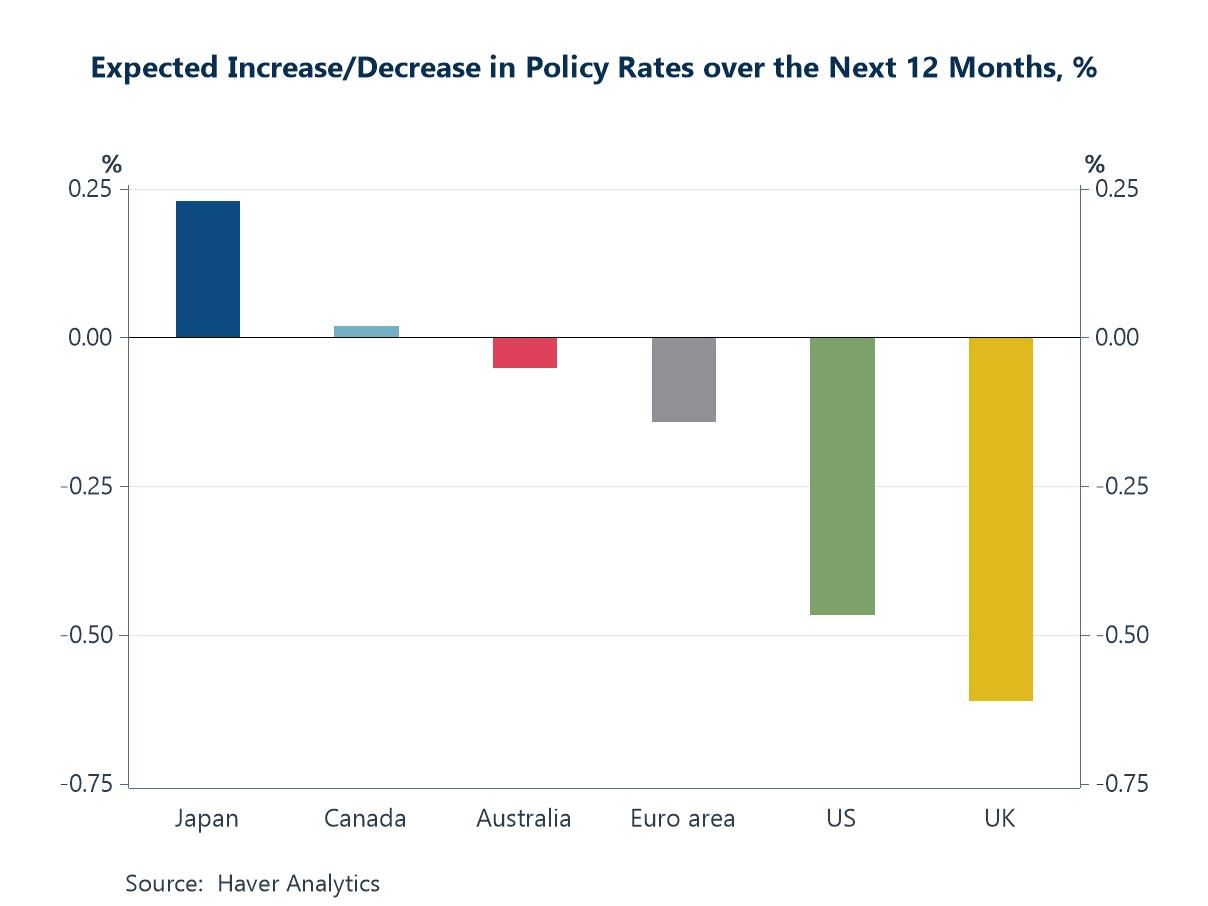 Global| Jan 27 2017
Global| Jan 27 2017U.S. GDP Growth Slows
by:Tom Moeller
|in:Economy in Brief
Summary
Economic growth decelerated during Q4'16 to 1.9% from a 3.5% gain in Q3. For all of last year, growth also decelerated to 1.6% from 2.6% in 2015. The Q4 figure fell short of expectations for a 2.1% rise in the Action Economics [...]
Economic growth decelerated during Q4'16 to 1.9% from a 3.5% gain in Q3. For all of last year, growth also decelerated to 1.6% from 2.6% in 2015. The Q4 figure fell short of expectations for a 2.1% rise in the Action Economics Forecast Survey.
Deterioration in the foreign trade deficit subtracted 1.7 percentage points from growth as exports fell 4.3% (+1.5% y/y). and imports increased 8.2% (2.5% y/y). The subtraction followed three consecutive quarters of addition. Most of last quarter's subtraction from foreign trade was offset by a 1.0 percentage point addition from faster inventory accumulation.
Growth in domestic final demand quickened to 2.5% (2.1% y/y). It was the swiftest growth since Q3'15, and led by a 10.2% jump in residential investment.
Personal consumption expenditures improved 2.5% (2.8% y/y), the weakest gain in three quarters. Spending on services decelerated to 1.3% (2.2% y/y), the weakest rise since Q3'13. Housing & utilities buying fell 2.0% (+1.4% y/y), but spending on recreation services rose 3.8% (0.4% y/y). Spending on durable goods rose a steady 10.9% (7.8% y/y). Recreational goods & vehicles purchases increased 16.2% (11.7% y/y) while motor vehicle & parts buying grew 11.7% (7.5% y/y). Furniture purchases rose 4.0% (6.0% y/y). In the nondurable goods sector, spending rebounded 2.3% (2.4% y/y) after a 0.5% slip. A 5.9% increase (4.7% y/y) in food store sales was offset by a 0.3% decline (+0.7% y/y) in apparel sales, as well as a 9.3% drop (-1.7% y/y) in gasoline & oil purchases.
Business fixed investment grew 2.4%. Structures spending declined 4.9% (+1.1% y/y), but equipment investment increased 3.1% (-3.6% y/y) following four straight quarters of decline. Industrial equipment investment strengthened 8.3% (2.6% y/y). Intellectual property products investment rose 6.4% (5.6% y/y), and information processing equipment investment increased a lessened 1.5% (0.5% y/y).
Government spending increased 1.2% (0.5% y/y). The gain was held back by a 1.2% decline (-0.2% y/y) in federal government purchases, reduced by a 3.6% shortfall (-2.0% y/y) in defense spending. State & local government purchases increased 2.6% (0.8% y/y) after two quarters of decline.
On the inflation front, the GDP chain price index increased 2.1%. The PCE price index rose 2.2%, but less food & energy the gain was a lesser 1.3%, its weakest rise in four quarters. The business fixed investment price index rose 1.0% (0.6% y/y) while the residential price index gained 3.2% (4.0% y/y).
The GDP figures can be found in Haver's USECON and USNA database. USNA contains virtually all of the Bureau of Economic Analysis' detail in the national accounts, including the integrated economic accounts and the recently added GDP data for U.S. Territories. The Action Economics consensus estimates can be found in AS1REPNA.
| Chained 2009 $ (%, AR) | Q4'16 (Advance Estimate) | Q3'16 | Q2'16 | Q4'16 Y/Y | 2016 | 2015 | 2014 |
|---|---|---|---|---|---|---|---|
| Gross Domestic Product | 1.9 | 3.5 | 1.4 | 1.9 | 1.6 | 2.6 | 2.4 |
| Inventory Effect | 1.0 | 0.5 | -1.2 | 0.0 | -0.4 | 0.2 | 0.0 |
| Final Sales | 0.9 | 3.0 | 2.6 | 1.9 | 2.0 | 2.4 | 2.5 |
| Foreign Trade Effect | -1.7 | 0.9 | 0.2 | -0.2 | -0.1 | -0.7 | -0.1 |
| Domestic Final Sales | 2.5 | 2.1 | 2.4 | 2.1 | 2.1 | 3.1 | 2.6 |
| Demand Components | |||||||
| Personal Consumption Expenditures | 2.5 | 3.0 | 4.3 | 2.8 | 2.7 | 3.2 | 2.9 |
| Business Fixed Investment | 2.4 | 1.4 | 1.0 | 0.3 | -0.4 | 2.1 | 6.0 |
| Residential Investment | 10.2 | -4.1 | -7.8 | 1.2 | 4.9 | 11.7 | 3.5 |
| Government Spending | 1.2 | 0.8 | -1.7 | 0.5 | 0.9 | 1.8 | -0.9 |
| Chain-Type Price Index | |||||||
| GDP | 2.1 | 1.4 | 2.3 | 1.6 | 1.3 | 1.1 | 1.8 |
| Personal Consumption Expenditures | 2.2 | 1.5 | 2.0 | 1.5 | 1.1 | 0.3 | 1.5 |
| Less Food/Energy | 1.3 | 1.7 | 1.8 | 1.7 | 1.7 | 1.4 | 1.6 |
Tom Moeller
AuthorMore in Author Profile »Prior to joining Haver Analytics in 2000, Mr. Moeller worked as the Economist at Chancellor Capital Management from 1985 to 1999. There, he developed comprehensive economic forecasts and interpreted economic data for equity and fixed income portfolio managers. Also at Chancellor, Mr. Moeller worked as an equity analyst and was responsible for researching and rating companies in the economically sensitive automobile and housing industries for investment in Chancellor’s equity portfolio. Prior to joining Chancellor, Mr. Moeller was an Economist at Citibank from 1979 to 1984. He also analyzed pricing behavior in the metals industry for the Council on Wage and Price Stability in Washington, D.C. In 1999, Mr. Moeller received the award for most accurate forecast from the Forecasters' Club of New York. From 1990 to 1992 he was President of the New York Association for Business Economists. Mr. Moeller earned an M.B.A. in Finance from Fordham University, where he graduated in 1987. He holds a Bachelor of Arts in Economics from George Washington University.


